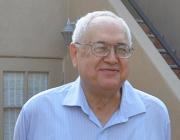Date Published:
AUG 18Abstract:
Molar absorption coefficients were measured for select alkyl nitrates and beta-hydroxyalkyl nitrates in methanol. The presence of the beta-hydroxyl group has a relatively minor effect on the absorption spectrum in the vicinity of the weak n -> pi* transition, which is responsible for photolysis of organic nitrates in the atmosphere. For both alkyl nitrates and beta-hydroxyalkyl nitrates, there is an enhancement in the absorption coefficients in solution compared to the gas-phase values. The effect of the beta-hydroxyl group on the spectra was modelled with molecular dynamics simulations using an OM2/GUGA-CI Hamiltonian for ethyl nitrate and beta-hydroxyethyl nitrate. The simulation provided a qualitatively correct shape of the low energy tail of the absorption spectrum, which is important for atmospheric photochemistry. The role of direct aqueous photolysis in removal of beta-hydroxyalkyl nitrates in cloud and fog water was modelled using a relative rate approach, and shown to be insignificant relative to gas-phase photochemical processes and aqueous OH oxidation under typical atmospheric conditions.
